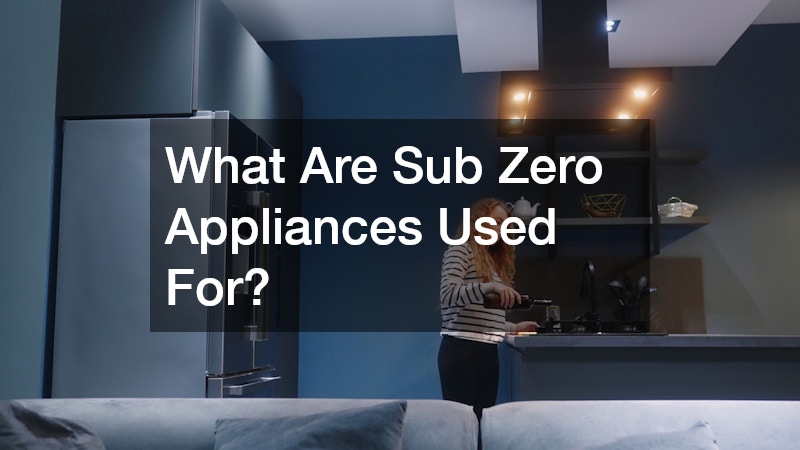Sub-Zero equipment is built to last, but premium performance depends on thoughtful care and timely, qualified service. From temperature stability to food preservation, a tuned system protects both groceries and your investment. Understanding what pros actually do, how to prep for an appointment, and which maintenance habits matter most will help you get the longest, quietest life from your refrigerator, freezer, wine storage, and ice maker. When you choose reputable sub zero appliance services, you also gain consistent documentation that supports warranty coverage and resale value.
Why Precision Matters With Built-In Cooling
Sub-Zero units rely on tight tolerances, robust compressors, and well-sealed, insulated cabinets. Small drifts in temperature or humidity can shorten produce life, dull flavors, and increase frost or condensate.
Over time, door gaskets compress, evap coils collect debris, and drains can partially clog. Left alone, those minor issues force the system to work harder, raising energy use and wear. Routine attention restores the designed airflow and balance between compartments so everything runs cooler, quieter, and more efficiently.
Common Symptoms You Should Not Ignore
Watch for these early warning signs: foods spoiling faster than usual, ice production slowing, visible frost on packages, persistent puddling near the toe kick, or fans cycling louder than normal. Warm spots on the cabinet frame, condenser coils covered in dust, and doors that rebound instead of sealing are also red flags. Addressing them quickly usually keeps the fix simple. Wait too long, and small problems can cascade into control board errors, compressor strain, or refrigerant issues that are more involved to correct.
What a Professional Visit Typically Includes
A thorough service call starts with a visual inspection, temperature and humidity checks, and verification of control settings. Techs clean and straighten condenser fins, measure amp draw, and test defrost and fan functions. They examine gaskets for uniform contact, clear drains, level the cabinet if needed, and calibrate sensors where the model allows. For wine storage, they verify dual-zone stability and vibration control; for ice makers, they check water filtration, fill valves, and harvest cycles. Detailed notes and before/after readings give you a clear record of the unit’s health.
DIY Care That Actually Helps
Homeowners can do a few high-impact tasks safely. Vacuum the condenser area every three to six months, keeping the grill and intake free of lint and pet hair. Wipe door gaskets with mild soap and water, then dry thoroughly so they stay supple and seal tight. Replace water filters on schedule to protect taste, ice clarity, and flow rates. Avoid overpacking shelves or blocking vents; good airflow is part of the design. These small habits reduce strain between professional visits and keep temperatures more consistent.
How Often Should You Schedule Service?
Usage, household size, pets, and kitchen dust all influence cadence. Many owners book annual or semiannual checkups to match seasonal cooking patterns and holiday loads. If you entertain often or store specialty items like dry-aged meats or delicate produce, consider a spring and fall rhythm to keep readings dead-on. Reputable sub zero appliance services will recommend an interval based on your model, environment, and historical readings rather than a one-size-fits-all guess.
Choosing the Right Provider
Look for factory training, ready access to genuine parts, and clear, itemized estimates. Ask whether the company records baseline temperatures, humidity, amp draw, and gasket measurements on every visit. That trend data helps catch tiny shifts before they become repairs. Confirm warranty literacy, liability insurance, and response windows for urgent issues. Online scheduling, text updates, and photo documentation are signs of a modern operation that values transparency. When you compare sub zero appliance services, consistency and measurement matter as much as speed.
Preparing for the Appointment
Clear a safe path to the unit, remove toe-kick grills if requested, and make note of recent symptoms with dates and typical loads. List any cleaning agents or unusual events (like a power surge) that might affect diagnosis. For built-ins, identify the circuit breaker and water shutoff location in case the tech needs them. If temperatures are unstable, avoid major grocery runs just before service; lighter loads make testing faster and more accurate.
Costs, Parts, and Long-Term Planning
Service pricing varies by market, model, and whether the call is routine or urgent. You can keep costs predictable by bundling maintenance across multiple units and approving replacement of wear items like gaskets before they fail. Ask for old parts to be returned or at least photographed, and request written test results after the work. Over a decade or more, that documentation becomes a maintenance history that supports insurance claims, listings, and future troubleshooting.
When Repair vs. Replace Comes Up
Sub-Zero products are designed for long service lives and professional repairability. Still, very old units may face part scarcity or efficiency gaps compared to newer designs. A candid technician can model likely repair trajectories based on hours, condition, and environment. If a replacement makes sense, plan ahead for cabinet dimensions, panel compatibility, and temporary cold storage so the transition is smooth.
Top-tier preservation depends on precision, cleanliness, and disciplined follow-through. Done right, your equipment rewards you with quiet reliability, better-tasting food, and a kitchen that performs like new for years.


